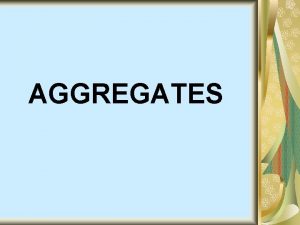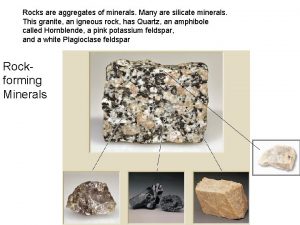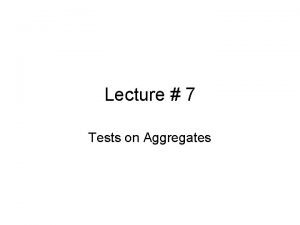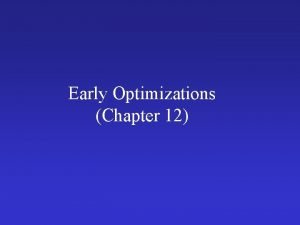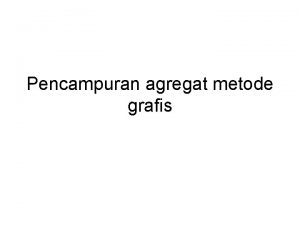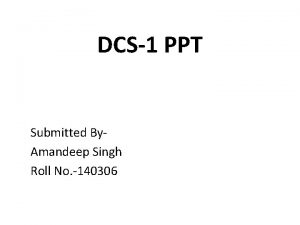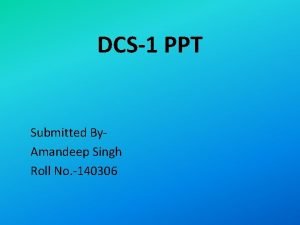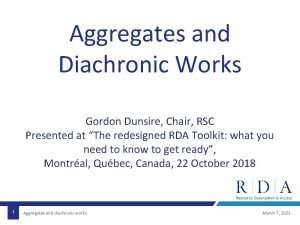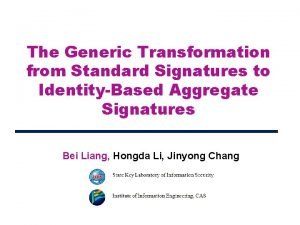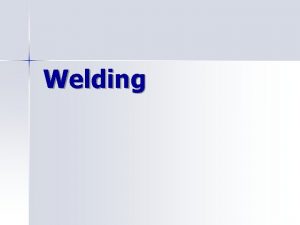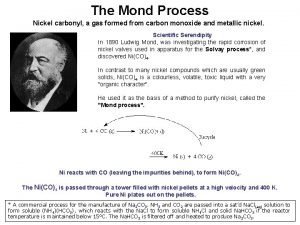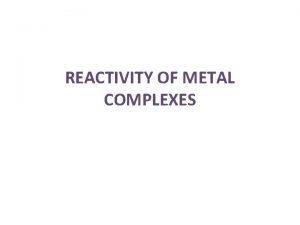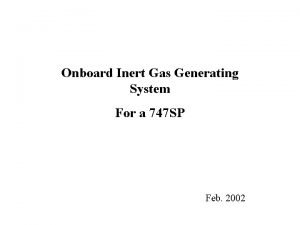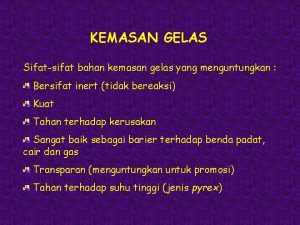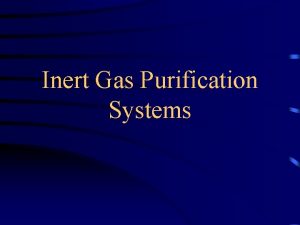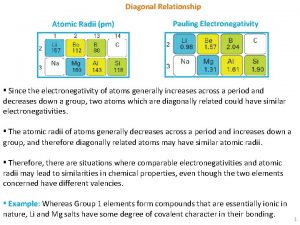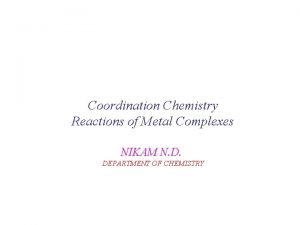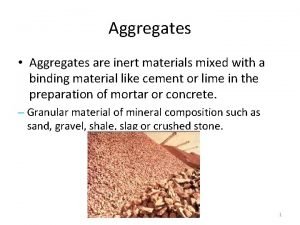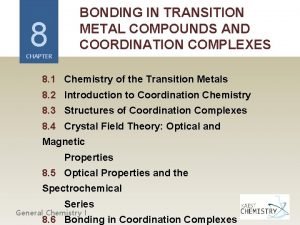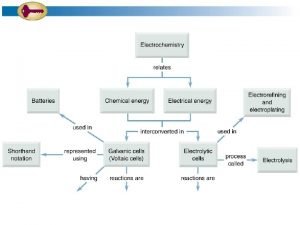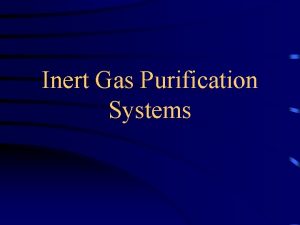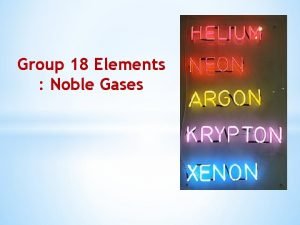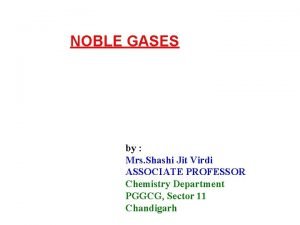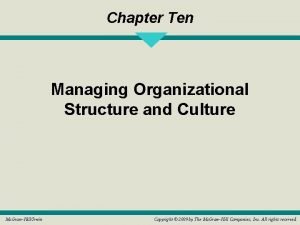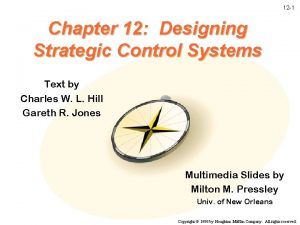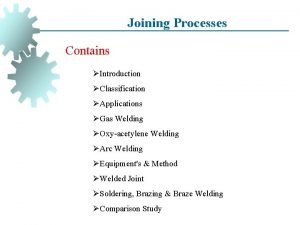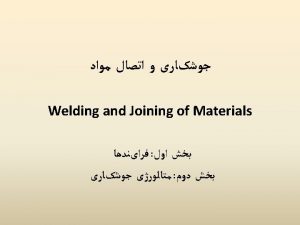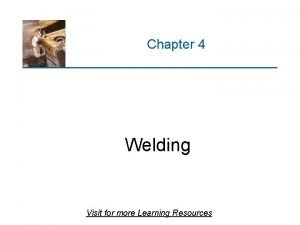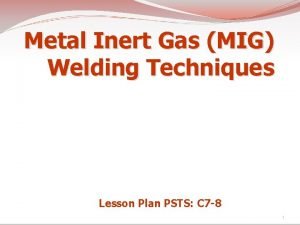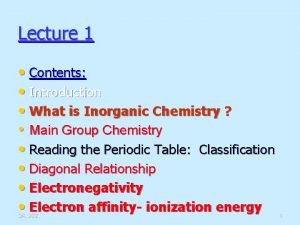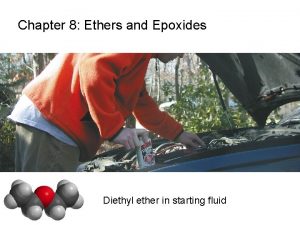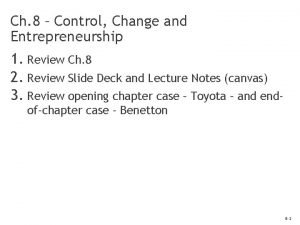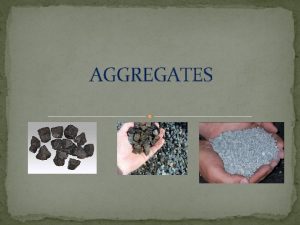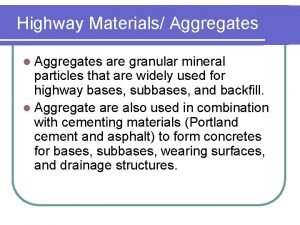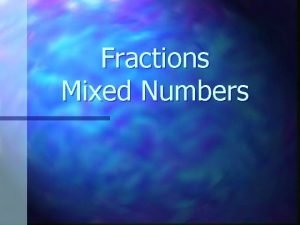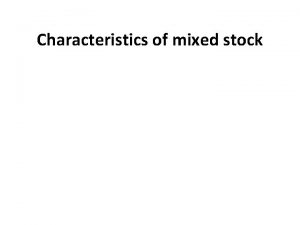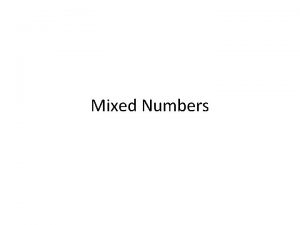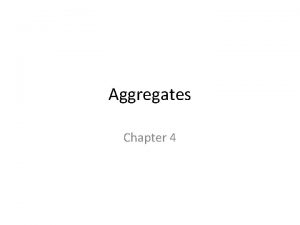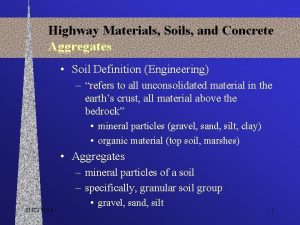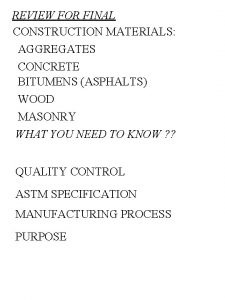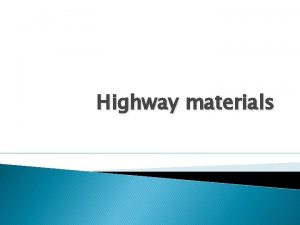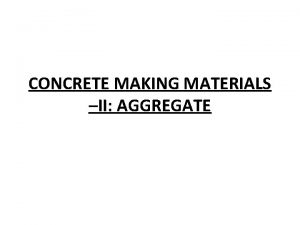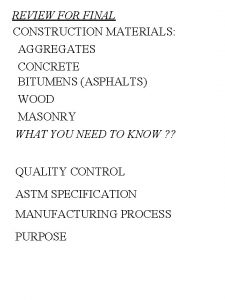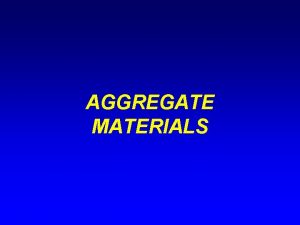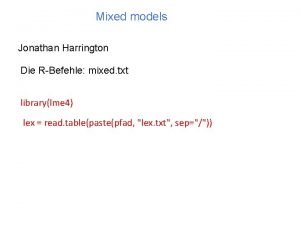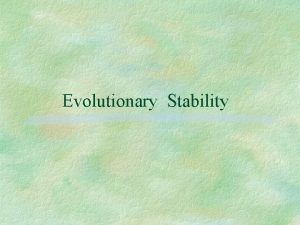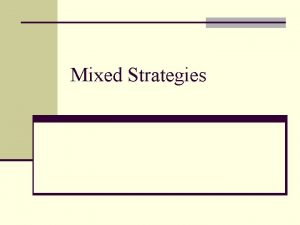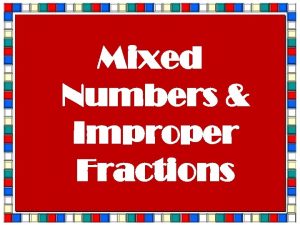AGGREGATES Aggregates are inert materials which are mixed









































- Slides: 41

AGGREGATES

Aggregates are inert materials which are mixed with binding material such as cement or lime for manufacturing of mortar or concrete. Aggregates are used as filler in mortar and concrete and also to reduce their cost. 2

CLASSIFICATION OF AGGREGATES

Depending upon the size of their particles aggregates are classified as: (1) Fine aggregates (2) Coarse aggregates Depending upon the shape of their particles aggregates are classified as: (1) Rounded aggregates (2)Irregular or partly rounded aggregates (3)Angular aggregates (4)Flaky aggregates (5)Elongated aggregates

Developed by: Nadeem Asghar 5

Developed by: Nadeem Asghar 6

(1) Fine Aggregates: Aggregates whose particles pass through 4. 75 mm IS sieve are termed as fine aggregates. Most commonly used fine aggregates are sand (pit or quarry sand, river sand sea sand) and crushed stone in powdered form, how ever some times sukhi and ash or cinder are also used. 7

(a) Sand: It consists of small angular or rounded grains of silica depending upon the source from which it is obtained. It is classified as: 8

(i) Pit or quarry sand: It is found as deposited in soil and is to be excavated out. Its grains are generally sharp or angular. It should be free from organic matter and clay. It is usually considered to be the best fine aggregate for use in mortar and concrete. 9

(ii) River Sand: It is obtained from the banks and beds of rivers. It may be fine or coarse. Fine sand obtained from beds and banks of rivers is often found mixed with silt and clay so it should be washed before use. But coarse sand is generally clean and excellent for use especially for plastering. 10

(iii) Sea Sand: It consists of fine rounded grains of brown colour and it is collected from sea shores or sea beaches. Sea sand usually contains salts and while using that in mortar, etc, causes disintegration of the work in which it is used. In R. C. C work these salts will attack reinforcement if salt content is high. These salts may cause efflorescence. It should be used locally after thorough washing. 11

(b) Crushed stone: It is obtained by crushing the waste stones of quarries to the particular size of sand. Sand obtained from by crushing a good quality stone is excellent fine aggregate. Mortar made with this sand is usually used in ashlar work (good quality of work). 12

(2) Coarse Aggregates: Aggregates whose particles do not pass through 4. 75 mm IS are termed as coarse aggregates. Most commonly used coarse aggregates are crushed stone, gravel; broken pieces of burnt bricks, etc. 13

(a) Crushed stone: It is an excellent coarse aggregate and is obtained by crushing granite, sand stone or grained lime stone and all types of stones. Crushed stones are used for the construction of roads and railway tracks, etc. 14

(b) Gravel: It is an other very good coarse aggregate. It is obtained from river beds, quarries and sea shores. The gravel obtained from sea shores should be well washed with fresh water before use in order to remove the impurities which may be clay, salts , silt, etc. It is commonly used in the preparation of concrete. 15

(c) Broken pieces of bricks: It is also a good artificial source of coarse aggregates. It is obtained by breaking well burnt bricks. It is generally used in lime concrete at places where aggregates from natural sources are either not available or are expensive. It can be used at places where low strength is required. It should be watered well before using it in the preparation of concrete. It is commonly used for mass concrete in foundations and under floors. 16

GOOD QUALITYIES OF AN IDEAL AGGREGATE: An ideal aggregate used for the manufacturing of concrete and mortar, should meet the following requirements. (1) It should consist of natural stones, gravels and sand or in various combinations of these materials. (2) It should be hard, strong and durable. 17

(3) It should be dense, clear and free from any coating. (4) It should be free from injurious vegetable matters. (5) It should not contain flaky (angular) and elongated pieces. (6) It should not contain any material liable to attack steel reinforcement in case of reinforced concrete. 18

CHARACTERISTICS OF AGGREGATES: Important characteristics of aggregates which influence the properties of resulting concrete mix are discussed as under: 19

Type of structure Max. size of aggregate 1. Mass concrete work 40 mm i. e. dams, retaining walls, piers and abutments, etc. 2. R. C. C work 20 mm i. e. beams, columns, etc 3. Flooring 10 mm It may be clearly noted that the size and shape of the aggregate particles influence the properties of freshly mixed concrete more as compared to those of hardened concrete. 20

QUALITY TESTS OF AGGREGATES: There are so many tests which are to be performed to check the quality of aggregates but some important tests are discussed below. 21

1. Crushing Test of Aggregate: The aggregate crushing value gives a relative measure of resistance of an aggregate to crushing under a gradually applied compressive load. The aggregate crushing strength value is useful factor to know the behaviour of aggregates when subjected to wear. Aggregate Crushing Value=(W 2/W 1)x 100 Crushing value not exceed: Aggregate used for concrete other than wearing surface 45% concrete for wearing surface-30% 22

Developed by: Nadeem Asghar 23

Developed by: Nadeem Asghar 24

Aggregate crushing value not more than Flexible pavements: WBM-50% BM-40% Bituminous surface dressing-30% Dense mix-30% Rigid pavements: Other than wearing course-45% Surface wearing course-30% Developed by: Nadeem Asghar 25

2. Impact Value Test: The aggregate impact value gives a relative measure of the resistance of an aggregate to sudden shock or impact. The impact value is some times used as an alternative to its crushing value. Aggregate Impact Value=(W 2/W 1)x 100 <10% - Exceptional strong 10 -20%-Strong 10 -30% Satisfactory for road surfacing >35%- Weak for road surfacing 26

Developed by: Nadeem Asghar 27

Developed by: Nadeem Asghar 28

3. Abrasion Value: The aggregate abrasion value gives a relative measure of resistance of an aggregate to wear when it is rotated in a cylinder along with some abrasive charge. Abrasion value not exceed: Aggregate to be used in Concrete wearing surfaces-30% Aggregate to be used in Other concrete-50% 29

Developed by: Nadeem Asghar 30

Developed by: Nadeem Asghar 31

SIEVE ANALYSIS: In determination of the proportions of the particles with in certain ranges in an aggregate by separation on various sieves of different size openings, may be defined as sieve analysis. 32

FINENESS MODULUS (F. M): The sum of cumulative percentage of residues retained on each of the Indian standard sieves (80 mm, 40 mm, 20 mm, 10 mm, 4. 75 mm, 2. 36 m m, 1. 18 mm, 600 microns, 300 microns and 150 microns each succeeding sieve has half the aperture of the previous one), divided by the 100, is known as “Fineness modulus” of the aggregates. The fineness modulus of an aggregate is roughly proportional to the average size of particles of the aggregates. 33

(OR) Index Number expressing the relative sizes of both coarse and fine aggregates is called “Fineness Modulus”. Sand Fineness Modulus Fine 2. 2 to 2. 6 Medium 2. 6 to 2. 9 Coarse 2. 9 to 3. 2 Note: It is recommended that the fineness modulus of sand should not be less than 2. 5 and should not be more than 3. 0 34

Aggregates are classified into two categories according to their size: Coarse Aggregates These are the aggregates which has size more than 4. 75 mm. In laboratories they are separated as the aggregates which are retained on the BIS test sieve no. 480. Generally broken stones are used as the coarse aggregates. Fine Aggregates These are the aggregates which has size less than 4. 75 mm. In laboratory they are classified as the aggregates which passes through the BIS sieve no. 480. In general, Natural river sand is used as a fine aggregate. Now we will discuss the characteristics of the coarse aggregates: As per IS: 383 -1963 shape of the particles of the aggregates may be round, angular and flaky. . Rounded particles do not have good interlocking, where as irregular and angular particles show very good inter-locking properties. Rounded particles show good workability. They should have a rough surface to get better bond between particles and cement paste. Porosity and water absorption should be less. Harmful ingredients such as iron pyrites, coal, mica, shale, clay, alkali and organic impurities should be avoided. These materials should not be present in such quantities that they may effect strength and durability of the concrete. Total amount of deleterious materials in 35 aggregates should not exceed 5%

Flakiness and Elongation Index Thickness gauge size=3/5 of mean dimension Length gauge size=9/5 of mean dimension Developed by: Nadeem Asghar 36

Thickness gauge Developed by: Nadeem Asghar 37

Length gauge Developed by: Nadeem Asghar 38

Developed by: Nadeem Asghar 39

Developed by: Nadeem Asghar 40

Thank You Developed by: Nadeem Asghar 41
 Antigentest åre
Antigentest åre Nadeem asghar
Nadeem asghar Rocks are aggregates of minerals
Rocks are aggregates of minerals Aggregate size
Aggregate size Sparse conditional constant propagation
Sparse conditional constant propagation Blending aggregates
Blending aggregates Grading of aggregates ppt
Grading of aggregates ppt Tests on aggregates ppt
Tests on aggregates ppt Gordon aggregates
Gordon aggregates F'cr concrete definition
F'cr concrete definition Ibas aggregates
Ibas aggregates Welding positions
Welding positions Mond process
Mond process Labile and inert complexes examples
Labile and inert complexes examples Onboard inert gas generation system
Onboard inert gas generation system Tungsten inert gas welding
Tungsten inert gas welding Tujuan kemasan bersifat inert
Tujuan kemasan bersifat inert Inert gas purification
Inert gas purification Diagonal relationship definition
Diagonal relationship definition Inert and labile complexes
Inert and labile complexes In an inert organizational culture,
In an inert organizational culture, Inert aggregate
Inert aggregate Spectrochemical series
Spectrochemical series Image of galvanic cell
Image of galvanic cell Inert gas purification
Inert gas purification Characteristics of the noble gases
Characteristics of the noble gases Chemical properties of noble gases
Chemical properties of noble gases Inert organizational culture
Inert organizational culture Inert organizational culture
Inert organizational culture Method of welding
Method of welding Tig (tungsten inert gas)
Tig (tungsten inert gas) Carbon arc welding
Carbon arc welding What is mig welding
What is mig welding Introduction to inorganic chemistry
Introduction to inorganic chemistry Epoxide plus grignard
Epoxide plus grignard Companies with an inert culture
Companies with an inert culture Natural materials
Natural materials Useful materials that can be found at home
Useful materials that can be found at home Man made map
Man made map Adopting materials
Adopting materials Direct materials budget with multiple materials
Direct materials budget with multiple materials Material that blocks light
Material that blocks light

